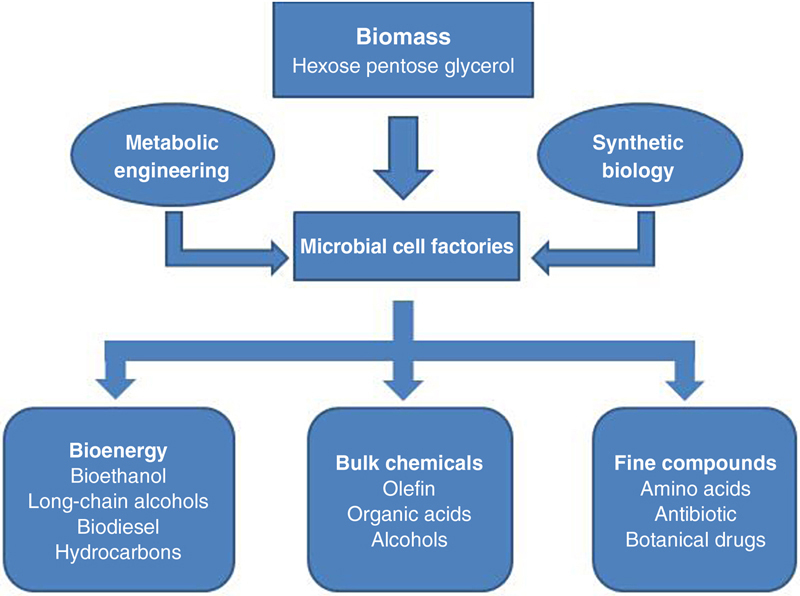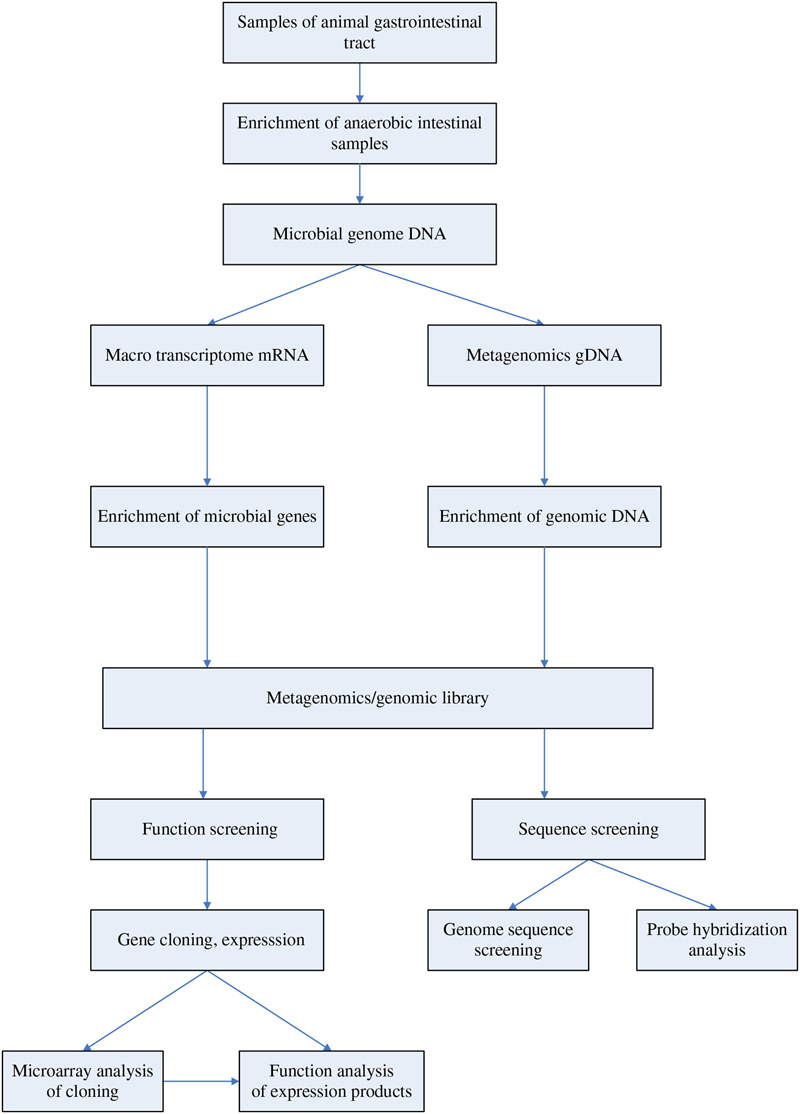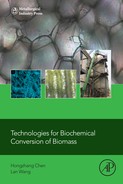References
Atsumi S, Hanai T, Liao JC. Non-fermentative pathways for synthesis of branched-chain higher alcohols as biofuels. Nature. 2008;451:86–89.
Bengtsson O, Jeppsson M, Sonderegger M, et al. Identification of common traits in improved xylose-growing Saccharomyces cerevisiae for inverse metabolic engineering. Yeast. 2008;25:835–847.
Bro C, Knudsen S, Regenberg B, et al. Improvement of galactose uptake in Saccharomyces cerevisiae through overexpression of phosphoglucomutase: example of transcript analysis as a tool in inverse metabolic engineering. Applied and Environmental Microbiology. 2005;71:6465.
Bro C, Regenberg B, Forster J, et al. In silico aided metabolic engineering of Saccharomyces cerevisiae for improved bioethanol production. Metabolic Engineering. 2006;8:102–111.
Chen H. Ecological high value conversion of straw resources: theory and application. Beijing: Chemical Industry Press; 2006.
Chen H. Biomass science and engineering. Beijing: Chemical Industry Press; 2008.
Chen H. Ecological biochemical engineering. Beijing: Chemical Industry Press; 2008.
Chen H. Process engineering in plant-based products. Beijing: Chemical Industry Press; 2010.
Chen HZ, Qiu WH. The crucial problems and recent advance on producing fuel alcohol by fermentation of straw. Progress in Chemistry. 2007;19:1116.
Chen HZ, Qiu WH. Key technologies for bioethanol production from lignocellulose. Biotechnology Advances. 2010;28:556–562.
Chen H, Wang L. Research progress on key process and intergrated eco-industrial chains of biobased products—proposal of biobased product process engineering. The Chinese Journal of Process Engineering. 2008;8:676–681.
Chen HZ, Li HQ, Liu LY. The inhomogeneity of corn stover and its effects on bioconversion. Biomass and Bioenergy. 2011;35(5):1940–1945.
Eliasson A, Christensson C, Wahlbom CF, et al. Anaerobic xylose fermentation by recombinant Saccharomyces cerevisiae carrying XYL1, XYL2, and XKS1 in mineral medium chemostat cultures. Applied and Environmental Microbiology. 2000;66:3381–3386.
Elowitz MB, Leibler S. A synthetic oscillatory network of transcriptional regulators. Nature. 2000;403:335–338.
Galazka JM, Tian C, Beeson WT, et al. Cellodextrin transport in yeast for improved biofuel production. Science. 2010;330:84.
Gardner TS, Cantor CR, Collins JJ. Construction of a genetic toggle switch in Escherichia coli. Nature. 2000;403:339–342.
Gibson DG, Glass JI, Lartigue C, et al. Creation of a bacterial cell controlled by a chemically synthesized genome. Science. 2010;329:52.
Hirasawa T, Nakakura Y, Yoshikawa K, et al. Comparative analysis of transcriptional responses to saline stress in the laboratory and brewing strains of Saccharomyces cerevisiae with DNA microarray. Applied Microbiology and Biotechnology. 2006;70:346–357.
Hirasawa T, Yoshikawa K, Nakakura Y, et al. Identification of target genes conferring ethanol stress tolerance to Saccharomyces cerevisiae based on DNA microarray data analysis. Journal of Biotechnology. 2007;131:34–44.
Hong SH, Kim JS, Lee SY, et al. The genome sequence of the capnophilic rumen bacterium Mannheimia succiniciproducens. Nature Biotechnology. 2004;22:1275–1281 http://news.sciencenet.cn/sbhtmlnews/2010/5/232185.html.
Jia K, Zhu Y, Zhang Y, et al. Group II intron-anchored gene deletion in Clostridium. PLoS One. 2011;6:e16693.
Jiang T, Li L, Ma C, et al. Strategies for regulating multiple genes in microbial cell factories. Chinese Journal of Biotechnology. 2010;26:1419–1425.
Jin SY, Chen HZ. Superfine grinding of steam-exploded rice straw and its enzymatic hydrolysis. Biochemical Engineering Journal. 2006;30:225–230.
Jin SY, Chen HZ. Fractionation of fibrous fraction from steam-exploded rice straw. Process Biochemistry. 2007;42:188–192.
Kamm B, Gruber PR, Kamm M. Biorefineries–industrial processes and products. Beijing: Chemical Industry Press; 2007.
Li Y. Metabolic engineering: an evolving technology for strain improvement. Chinese Journal of Biotechnology. 2009;25:1281–1284.
Liu D, Du J, Zhao G, et al. Application of synthetic biology in medicine and energy. CIESC Journal. 2011;62:2391–2397.
Ma G, Wang P, Su Z. Nanoscience and enzyme. China Basic Science. 2009;5:49–54.
Ma Q, Lin D, Yao S. Immobilization of mixed bacteria by microcapsulation for hydrogen production—a trial of pseudo “Cell Factory”. Chinese Journal of Biotechnology. 2010;10:1444–1450.
Mori T, Mizuta S, Suenaga H, et al. Metagenomic screening for bleomycin resistance genes. Applied and Environmental Microbiology. 2008;74(21):6803–6805.
Nissen TL, Kielland-Brandt MC, Nielsen J, et al. Optimization of ethanol production in Saccharomyces cerevisiae by metabolic engineering of the ammonium assimilation. Metabolic Engineering. 2000;2:69–77.
Pu Y, Zhong Y, Zheng Z. The effect s of mixed culturing on the growth and nitrogen fixation of nitrogen-fixating bacteria and cellulolytic organism. Amino Acids & Biotic Resources. 2000;22:15–18.
Qu W, Yue X. Cell immobilization technique and its research progress. Shaanxi Journal of Agricultural Sciences. 2007;6:121–123.
Shen X, Xia L. Synergetic saccharification and lactic acid fermentation by coimmobilized cells using cellulosic materials. Journal of Chemical Industry and Engineering. 2008;1:167–172.
Si-Mei R, Xue Q, Cai Y. The effect of mixed fermentation on cellulase and amylase activities. Journal of Northwest Sci-Tech University of Agriculture and Forestry. 2002;30:69–73.
Song P, Zhou M, Chen W. A study on the fermentation process of microbial fertilizer with complex microbial community. Shanghai Environmental Science. 2008;4:156–161.
Steen EJ, Kang Y, Bokinsky G, et al. Microbial production of fatty-acid-derived fuels and chemicals from plant biomass. Nature. 2010;463:559–562.
Tan H, Wang L, Zhao Z. Mechanism of DNA transformation based on mineral nanofibers and method improvement. Chinese Journal of Biotechnology. 2010;26:1379–1384.
Toivari MH, Aristidou A, Ruohonen L, et al. Conversion of xylose to ethanol by recombinant Saccharomyces cerevisiae: importance of xylulokinase (XKS1) and oxygen availability. Metabolic Engineering. 2001;3:236–249.
Tu X, Xue Q, Si-Mei R, et al. Effects of mixed poly-fermentation on cellulase activity. Industrial Microbiology. 2004;34:30–34.
Wang C, Huang B, Luo H. Immobilized microbe technology and its application. Yunnan Chemical Technology. 2007;34:79–82.
Wang J, An P, Liu J. The new progress of metagenomics in the research of rumen microbial metabolization. Chinese Journal of Animal Nutrition. 2010;3:527–535.
Wang Z, Peng J, Hu Y, et al. Advance of synthetic biology in industrial application. Scientia Sinica Chimica. 2011;41:709–716.
Wexler M, Bond PL, Richardson DJ, et al. A wide host-range metagenomic library from a waste water treatment plant yields a novel alcohol/aldehyde dehydrogenase. Environmental Microbiology. 2005;7:1917–1926.
Xie X, Zhou H, Gao Z, et al. Study and application of coupled multienzyme reaction systems. Chemical Industry and Engineering Progress. 2004;8:864–868.
Xu Y, Duan C, Zhou Q, et al. Cloning and identification of cellulase genes from uncultured microorganisms in pulp sediments from paper mill effluent. Acta Microbiologica Sinica. 2006;46:783–788.
Xu X, Wang X, Ma C. Recent progress of the research on spore surface display. Chinese Journal of Biotechnology. 2010;26:1404–1409.
Yang J, Fan W, Xiao H, et al. Genome shuffling method of Bacillus subtilis. Chinese Journal of Biotechnology. 2010;26:1385–1392.
Zehr JP, Bench SR, Carter BJ, et al. Globally distributed uncultivated oceanic N2-fixing cyanobacteria lack oxygenic photosystem II. Science. 2008;322:1110.
Zhang X. Twenty years development of metabolic engineering—a review. Chinese Journal of Biotechnology. 2009;25:1285–1295.
Zhang Y, Hou H. Advances in microbial mixed fermentation and production cellulase research. Liquor Making. 2010;3:20–23.
Zhang Y, Li Y, Ma Y. Microbial cell factories and biorefinery. Progress in Chemistry. 2007;19:1076–1083.
Zhang YHP, Evans BR, Mielenz JR, et al. High-yield hydrogen production from starch and water by a synthetic enzymatic pathway. PLoS One. 2007;2:e456.
Zhang L, Chang S, Wang J. Synthetic biology: from the first synthetic cell to see its current situation and future development. Chinese Science Bulletin. 2010;55:3477–3488.
Zhao X, Wang J, Chen T, et al. Metabolic engineering in the post genomic era: opportunities and challenges. Chinese Journal of Bioprocess Engineering. 2004;2:2–7.
Zhao X, Bai F, Li Y. Application of systems biology and synthetic biology in strain improvement for biofuel production. Chinese Journal of Biotechnology. 2010;26:880–887.
Zheng R. Research advance in production of SCP feed by microbial mixed fermentation. Acta Agriculturae Jiangxi. 2011;23:133–135.





